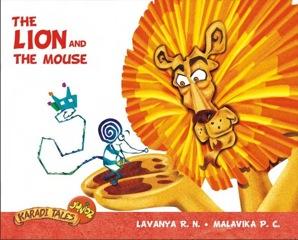
The Lion and the Mouse, released by Karadi Tales, India, is one of four in a series of picture book Indian fables and folktales featuring a mixture of prose, rhyme and song. It was authored by Lavanya R. N., narrated by Karthik Kumar (Evam), musically accompanied by Anil Srinivasan, and illustrated by Malavika P.C.
One must view this audio book on their computer or E Reader to fully appreciate the blending of artistic talents. The audio sounds of the roaring of the lion, the mouse’s squeaky singing of the seven notes and nibbling of holes in the lion’s net; plus, the clear dramatic prose narration and fun illustrations make it all flow together engaging one’s attention to the very end. My first reaction was that it was too long for a children’s picture book, but the E Reader version held my attention with its’ smooth page turns. I thought the ending a bit abrupt. Maybe it was just that I was disappointed that the ending had come. I wanted to keep enjoying the unique musical notes prompting when to turn the page.
The Lion and the Mouse storyline is simple: A tiny mouse disturbs a huge lion. The lion catches the mouse, the mouse begs to be set free, and the lion lets him go. When the lion runs into trouble by getting caught in a hunter’s net, the tiny mouse repays him by chewing through the net so he too can be free.
Fables are short stories which illustrate a particular moral and subtly teach a lesson to children. What do you think the moral or lesson of this story is? When you read or watch this book with children it provides opportunity for much dialogue. Ask the children questions: Why did the lion release the mouse? Did the lion expect anything in return? How did the lion feel when the mouse returns to free him? How are the mouse and lion different? How are the mouse and the lion the same?
Historical data reveals that The Lion and the Mouse, one of Aesop’s Fables, dates back to the 5th Century BC. Through the centuries, there have been many versions world-wide, not only by authors, but also by artists and sculptors. An interesting tidbit is that a popular painting of this fable used to hang in the Great Hall at Westminster and was retouched by Winston Churchill to highlight the barely visible mouse. In 1973, the painting was restored and the overprinting removed; it now hangs in the Great Parlor of the Palace of Westminster.
Also, in 2010, Jerry Pinkney, USA, published a version that won the prestigious Caldecott Medal for illustration. There are many historical facts recorded about this fable. Children find this story especially appealing because, in characteristic fable style, the main characters are animals that act and talk like people but retain their animal traits. The story of The Lion and the Mouse has always been popular. This audio version, published by Karadi Tales, India, with its’ teaming of talented artists and delightful narration, is an exceptional endeavor utilizing modern-day technology.
The entire book is available to download. Click on http://issuu.com/karaditales/docs/lionmouse